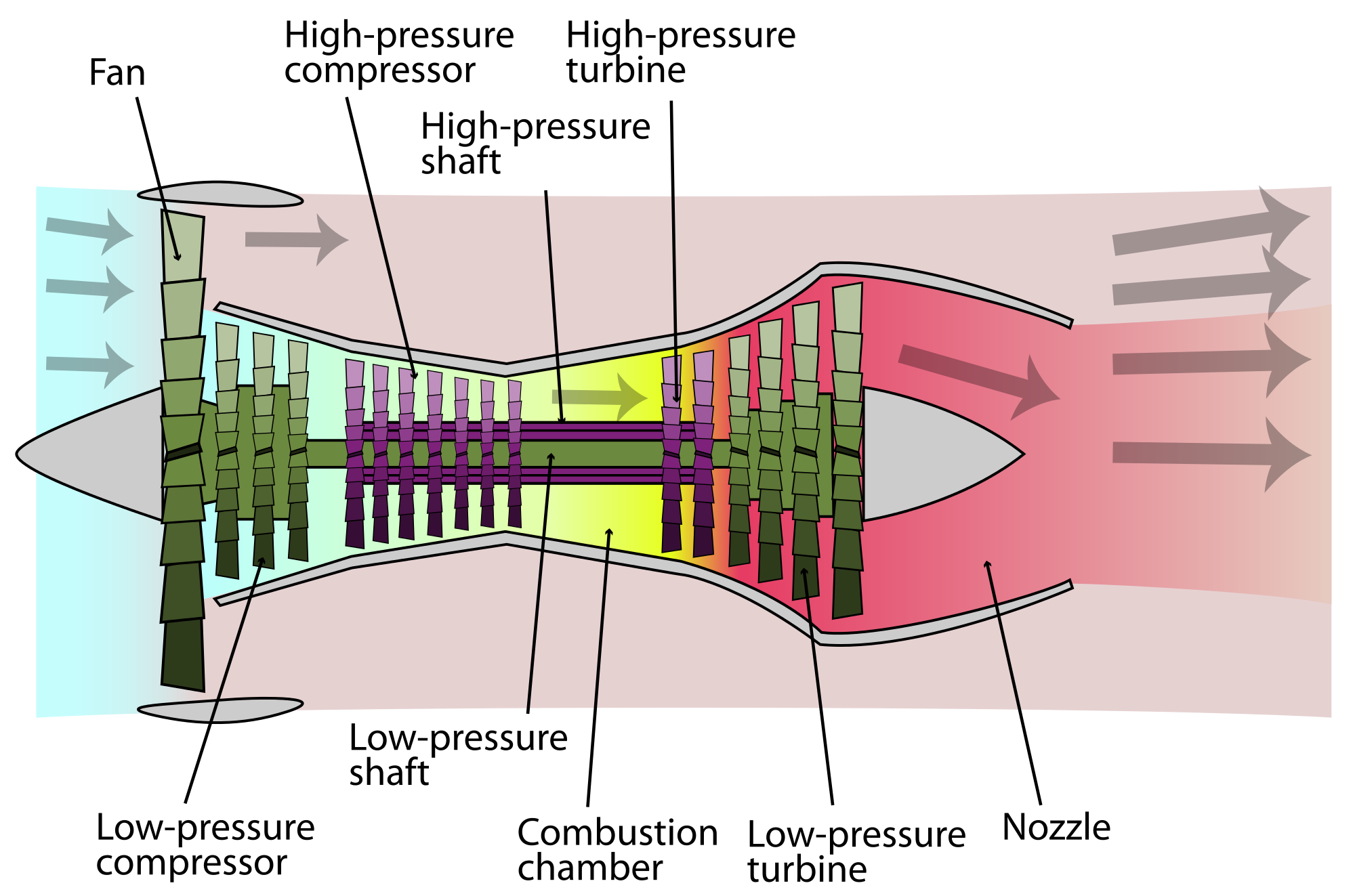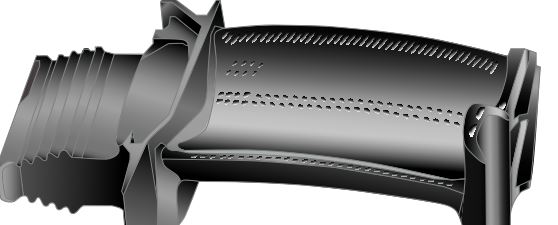Short answer
Fan: Aluminum, titanium, or stainless steel
Compressor: Nickel-, cobalt-, or iron-based alloys. Additive are aluminum and/or titanium, chromium, as well as rare earth elements like yttrium.
Combustion chamber: Superalloys with refractory metals such as tungsten, molybdenum, niobium, tantalum. Ceramics and ceramic-metal mixes.
Turbine: Nickel-based superalloy, outside air is circulated through channels inside of the turbine blades. For lower pressure turbine blades iron-based superalloy or even stainless steel. The metals used for turbine blades are often grown as a single crystal.
Exhaust nozzle: Nickel Inconel and stainless steel alloys.
Casing: Aluminum or polymer matrix materials.
The high-pressure turbine is, with the combustion chamber, very hot (more than the exhaust nozzle). You may read this Wikipedia article which has a short list of materials used for turbine blades (with alloys names and cooling techniques).
Engine structure (turbofan)

(source: Wikipedia)
(To understand temperatures and pressures, remember the fan pushes about one ton of air per second in high power turbofans.)
All quotes are from Nasa Guide To Engines, 2007, except stated otherwise.
In 1903, the Wright brothers built an aluminum block engine because of its light weight compared to cast iron. Its melting point of 660 °C was well above the engine’s operating temperature, so for them it was a good choice. However, aluminum could not be used in the hotter parts of a turbine engine where temperatures reach of 1800 °C or more because it would melt.
Fan
This typically does not get very hot (<150 °C) so aluminum, titanium, or stainless steel are all suitable for the fan blades. Most engines use titanium because it has a high strength-to-weight ratio, is corrosion and fatigue resistant, and would be able to withstand the impact of a bird strike.
Compressor section
The pressure of the air can be raised up to 30 times and the temperature, depending on the number of stages in the compressor, can rise to 1000 °C. Here the materials must have high strength at high temperatures; must resist fatigue, cracking, and oxidation; and also must resist “creep.” Creep is the tendency of a material to slowly change shape when stressed at high temperature. Since no single metal would have all the desired properties, an alloy (a mixture of metals) is used. Very high- temperature alloys are called superalloys and are generally nickel-, cobalt-, or iron-based alloys. Aluminum and/or titanium are added for strength, and chromium, as well as rare earth elements like yttrium, are added to improve corrosion resistance.
Combustion chamber
Temperatures can exceed 1800 °C and again superalloys are used, but without the titanium or aluminum for strength because there are no moving parts. Instead, refractory metals are often added to a superalloy. These are metals of unusually high resistance to heat, corrosion, and wear such as tungsten, molybdenum, niobium, tantalum, and rhenium. They are used in alloys and not as pure metals because they are among the densest of all the elements, a negative property when it comes to aircraft that need to keep weight to a minimum. Ceramics and ceramic-metal mixes are also used here because of their high heat resistance. We are familiar with pottery, tile, crucibles, and fire bricks as types of ceramics. They have very high melting points and don’t require the cooling systems like those needed to keep metals from melting so they make for lighter, less complicated engine parts. The down side is that they tend to fracture under stress, so engineers seek to create new ceramics composites that incorporate other materials to improve properties.
Turbine

High-pressure turbine blade (source: Wikipedia)
The first set of turbine blades are in the highest pressure, hottest part of the gas flow and are generally made of nickel-based superalloy or ceramic blades. Unheated outside air is circulated through channels inside of the turbine blades to keep them from melting in this extreme environment. Further down the engine lower pressure turbine blades often sit. Since the gases have somewhat cooled by this point, the blades can be made of iron-based superalloy or even stainless steel. It is interesting to note that for strength, the metals used for turbine blades are often grown as a single crystal. A close look at most metals and alloys show that they are composed of crystals (also called “grains”), and the places where the crystals meet are called grain boundaries. A material is weaker at the grain boundaries than within the grains—especially at high temperatures— so turbine blades fashioned from metal formed as a single grain (no boundaries) are stronger.
Exhaust

Exhaust from Boeing 787 engine (GEnx, one of the world's largest jet engine - Source)
From FAA Aviation Maintenance Technician Handbook - FAA-8083-30:
Inconel and stainless steel alloys. The Inconel [nickel-chromium-iron] alloys are frequently used in turbine engines because of their ability to maintain their strength and corrosion resistance under extremely high temperature conditions.
See Inconel details.
Casing
Although it need not withstand high temperatures like the core of the turbine, the materials here need to be strong enough that if a blade were to break off it would be contained within the casing and not enter the wing or cabin of the aircraft and cause further damage. Aluminum or some polymer matrix materials are used as engine casings.
